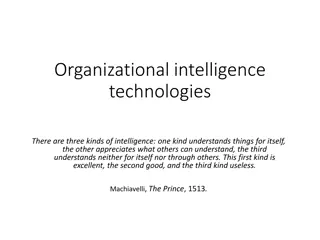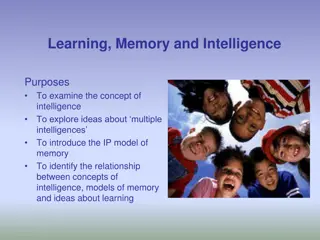Decision Support Systems for Business Intelligence
This chapter delves into the nature of decision making, forms of rationality, causes of satisficing behavior, perception challenges, and the importance of using data to challenge assumptions in the realm of business intelligence. It emphasizes the significance of information attributes and describes the measures of success for BI projects, including improved business performance, enhanced data access, stakeholder support, and user perception.
Uploaded on Jul 22, 2024 | 1 Views
Download Presentation

Please find below an Image/Link to download the presentation.
The content on the website is provided AS IS for your information and personal use only. It may not be sold, licensed, or shared on other websites without obtaining consent from the author. Download presentation by click this link. If you encounter any issues during the download, it is possible that the publisher has removed the file from their server.
E N D
Presentation Transcript
Chapter 2 Decision Making Decision Support Systems For Business Intelligence
Figure 2.1: Nature of Decision Making Sauter, V.L. , Decision Support Systems for Business Intelligence, John Wiley, 2010
Figure 2.2: Forms of Rationality Sauter, V.L. , Decision Support Systems for Business Intelligence, John Wiley, 2010
Figure 2.3: Causes of Satisficing Behavior Sauter, V.L. , Decision Support Systems for Business Intelligence, John Wiley, 2010
Figure 2.4: Perception is Not Always Obvious Sauter, V.L. , Decision Support Systems for Business Intelligence, John Wiley, 2010
Figure 2.5: Is This a Car or a Truck? Sauter, V.L. , Decision Support Systems for Business Intelligence, John Wiley, 2010
Figure 2.6: Attributes of Information Sauter, V.L. , Decision Support Systems for Business Intelligence, John Wiley, 2010
Figure 2.7: Using Data to Challenge Assumptions Sauter, V.L. , Decision Support Systems for Business Intelligence, John Wiley, 2010
Figure 2.8: Using Data to Challenge Assumptions Sauter, V.L. , Decision Support Systems for Business Intelligence, John Wiley, 2010
Figure 2.9: An Early View of BI Sauter, V.L. , Decision Support Systems for Business Intelligence, John Wiley, 2010
Table 2.1: Measures of Success of BI Projects Measures of Success of BI Projects* Improved Business Performance Better Access to Data Support of Key Stakeholders User Perception that it is Mission Critical ROI % of Active Users Cost Savings Number of Defined Users Other measures of success included: Number of BI Applications Number of New Requests for BI Applications Number of Standard ad hoc Reports Elimination of independent (shadow) spreadsheets Increased Employee Satisfaction Increased Customer Service Time Reduced 70% 68% 53% 50% 43% 31% 31% 17% *Adapted from Howson, C., Successful Business Intelligence: Secrets to making BI a Killer Application, New York: McGraw Hill, 2008. Sauter, V.L. , Decision Support Systems for Business Intelligence, John Wiley, 2010
Table 2.2: Necessary Features of Successful BI Necessary Features of Successful BI High data quality and clean data Reliability of the system Availability of relevant subject areas Appropriate and effective BI tools Fast query response time BI being continually improved (both data and tools) Integration of BI into organizational processes Near real time updates to the data warehouse Sauter, V.L. , Decision Support Systems for Business Intelligence, John Wiley, 2010
Figure 2.10: Demonstration of Microsofts Tool, Pivot Sauter, V.L. , Decision Support Systems for Business Intelligence, John Wiley, 2010

























